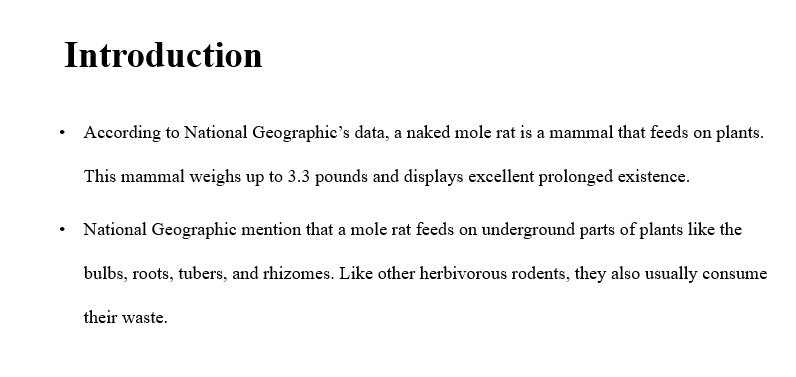“Naked Molerat”; Describe your study species: a. Provide the natural history and ecology (e.g. feeding behaviors, any predators,
“Naked Molerat”
Overall Structure: 1. Presentations must be 10 minutes in length. 2. Approximately 5 minutes will be given for questions following each presentation.
Background: 1. Describe your study species: a. Provide the natural history and ecology (e.g. feeding behaviors, any predators, trophic positioning, and time the species is active). b. Describe mating patterns, distribution, and conservation status, if applicable. c. Outline any fun facts that relate to your study species.
Study 1: 1. Discuss one study from Assignment 2 that examines the ecology of your species a. Introduction: Introduce the main topic along with the central questions and/or hypotheses. b. Methods: Be able to describe the overall experimental design and general statistical analyses (we understand some studies are hard to follow but do the best you can). c. Results: Present the results using tables and figures that were presented in the paper. Do not feel the need to present every result, but enough to get the main point of the results section. d. Discussion: Provide the overall takeaway from the study. Make sure to include both your own interpretation, as well as the author’s interpretation of the results.
Bibliography: 1. Provide a bibliography or references cited on your last PowerPoint slide. Make sure it follows the Ecology journal format.
Quick tips for a good presentation: 1. Refrain from using overly wordy slides; your slides should be readable from any location in the class. 2. Your figures should also be clear. The text in each figure should be readable. Try to limit the amount of figures on one slide. Figures are generally better than tables. 3. Take your time when giving a presentation. Do not rush through your slides. 4. Limit the amount of reading you do from your slides. Give as much eye contact as possible. You want to engage with your audience. 5. Make sure to speak with volume and practice your talk ahead of time.
MY Titles of 10 articles: from assignment 2 1) “Cardiac metabolomic profile of the naked mole-rat-glycogen to the rescue” 2) “The microenvironment of naked mole-rat burrows in East Africa” 3) “Growth affects dispersal success in social mole-rats, but not the duration of philopatry” 4) “Eusociality in African mole-rats: new insights from patterns of genetic relatedness in the Damaraland mole-rat (Cryptomys damarensis)” 5) “Dispersal and new colony formation in wild naked mole-rats: evidence against inbreeding as the system of mating” 6) “Are naked and common mole-rats eusocial and if so, why?” 7) “Family values: group dynamics and social control of reproduction in African mole-rats” 8) “Behavioural responses of naked mole rats to acute hypoxia and anoxia” 9) “A multiplex PCR assay for molecular sexing of the naked mole-rat (Heterocephalus glaber)” 10) “No evidence for the work-conflict hypothesis in the eusocial naked mole-rat (Heterocephalus glaber)”
Answer preview for “Naked Molerat”; Describe your study species: a. Provide the natural history and ecology (e.g. feeding behaviors, any predators,

APA
892 Words